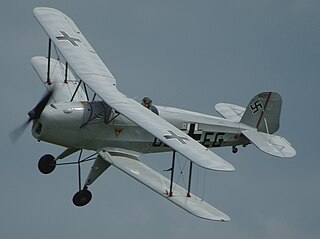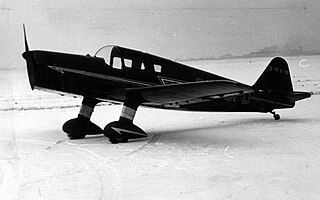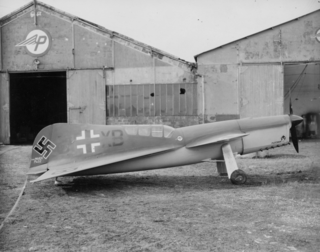
The Bücker Bü 131 Jungmann is a German 1930s basic training aircraft which was used by the Luftwaffe during World War II.
Pilatus Aircraft Ltd. is an aerospace manufacturer located in Stans, Switzerland. In June 2016, the company employed 1,905 people.

The Pilatus P-2 is a trainer aircraft designed by Swiss manufacturer Pilatus in 1942 and first flown on April 27, 1945. It was used by the Swiss Air Force from 1946 until 1981. The Pilatus P-2 emerged from an unbuilt project of the Pilatus P-1, which can be seen as a single-seat version of the P-2.

The Pilatus P-3 was a military training aircraft built by Pilatus Aircraft of Switzerland.

The Argus As 10 was a German-designed and built, air-cooled 90° cylinder bank-angle inverted V8 "low power" aircraft engine, used mainly in training aircraft such as the Arado Ar 66 and Focke-Wulf Fw 56 Stösser and other small short-range reconnaissance and communications aircraft like the Fieseler Fi 156 Storch during, and shortly after World War II. It was first built in 1928.

The Gotha Go 145 is a German World War II-era biplane of wood and fabric construction used by Luftwaffe training units. Although obsolete by the start of World War II, the Go 145 remained in operational service until the end of the War in Europe as a night harassment bomber.

The Bücker Bü 180 Student was a 1930s German two-seat sporting/training aircraft built by Bücker Flugzeugbau.

The Letov Š-28 was a Czechoslovak single-engined, two-seat reconnaissance aircraft. It was manufactured by Letov Kbely in a number of versions with different powerplants. The most important version was the Š-328, which was produced in relatively high quantities.

The Letov Š-31 was a fighter aircraft produced in Czechoslovakia in the early 1930s in a number of variants. All of the aircraft had metal tubular framing and fabric covering with a metal engine cowling.

The Pilatus P-4 was a Swiss five-seat cabin monoplane designed and built by Pilatus, but had little sales success.

The RWD-19 was a Polish two-seat low-wing sports aircraft of 1938, constructed by the RWD bureau.

The Dornier Do E was a small German flying boat of 1924, designed for reconnaissance missions.

The Payen PA-22 was a French experimental aircraft designed by Nicolas Roland Payen.

The Mylius My-103 Mistral is a German two-seat aerobatic trainer of utility aircraft produced by Mylius Flugzeugwerk of Bitburg.

The Pilatus P-1 was a single-engined, single-seat training aircraft project from Pilatus Aircraft in Switzerland, ca.1941.
The Pilatus PC-10 was the common name of different designs for a twin-engine aircraft manufacturer Pilatus Aircraft, but none of them reached the production stage.
The Junkers Profly Ultima is a German aerobatic homebuilt aircraft that was designed by Andre Konig and produced by Junkers Profly of Kodnitz, introduced in 1993. When it was available the aircraft was supplied as a kit for amateur construction.

The Zeppelin-Lindau Rs.IV was a Riesenflugzeug monoplane all metal flying boat with a stressed skin hull and fuselage developed for the Imperial German Navy to perform long range patrols over the North Sea. It had been developed by Claudius Dornier while working for Zeppelin in the town of Lindau.

The Kalinin K-1, also known as RVZ-6, was a Soviet passenger plane that could carry three people.
The Kalinin K-2 was a Soviet airliner designed and built by the designer Konstantin Kalinin. The aircraft was a variant of the predecessor K-1 with a stronger engine and an all-metal construction. The total weight of the construction exceeded that of the planning considerably. The first flight took place in 1926. The assembly was more complex than the K-1, but only four were built.
















